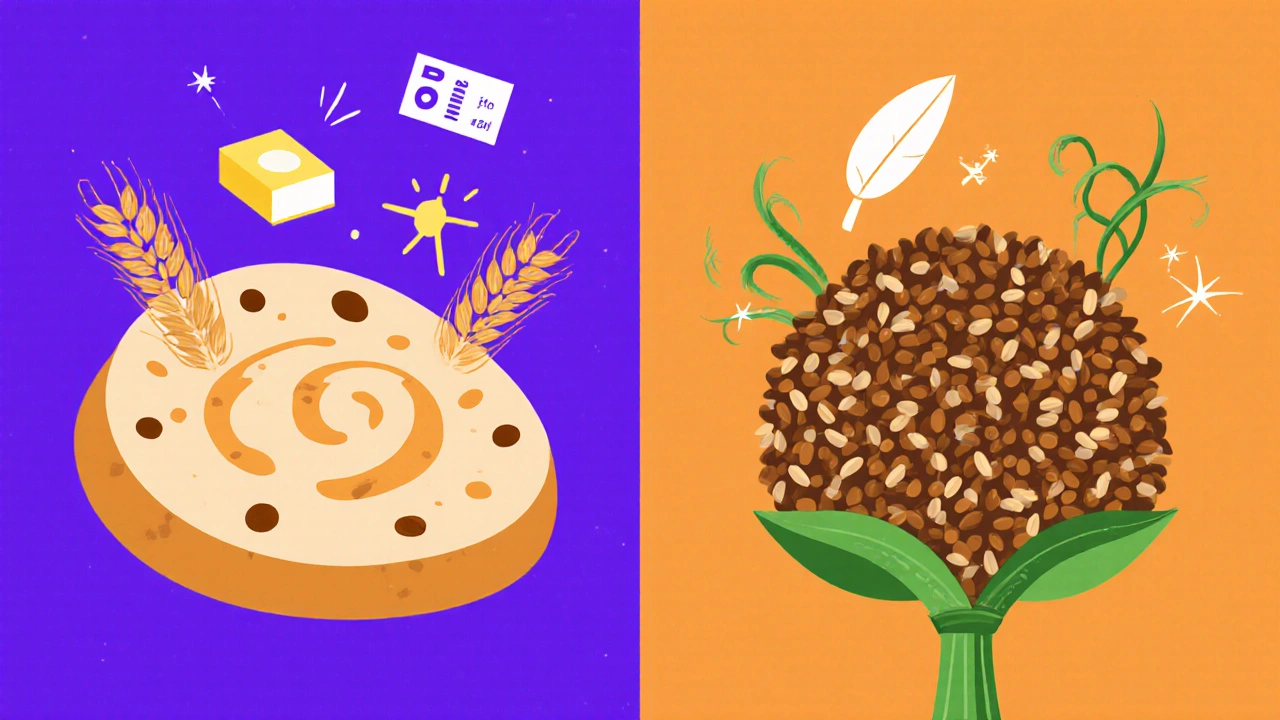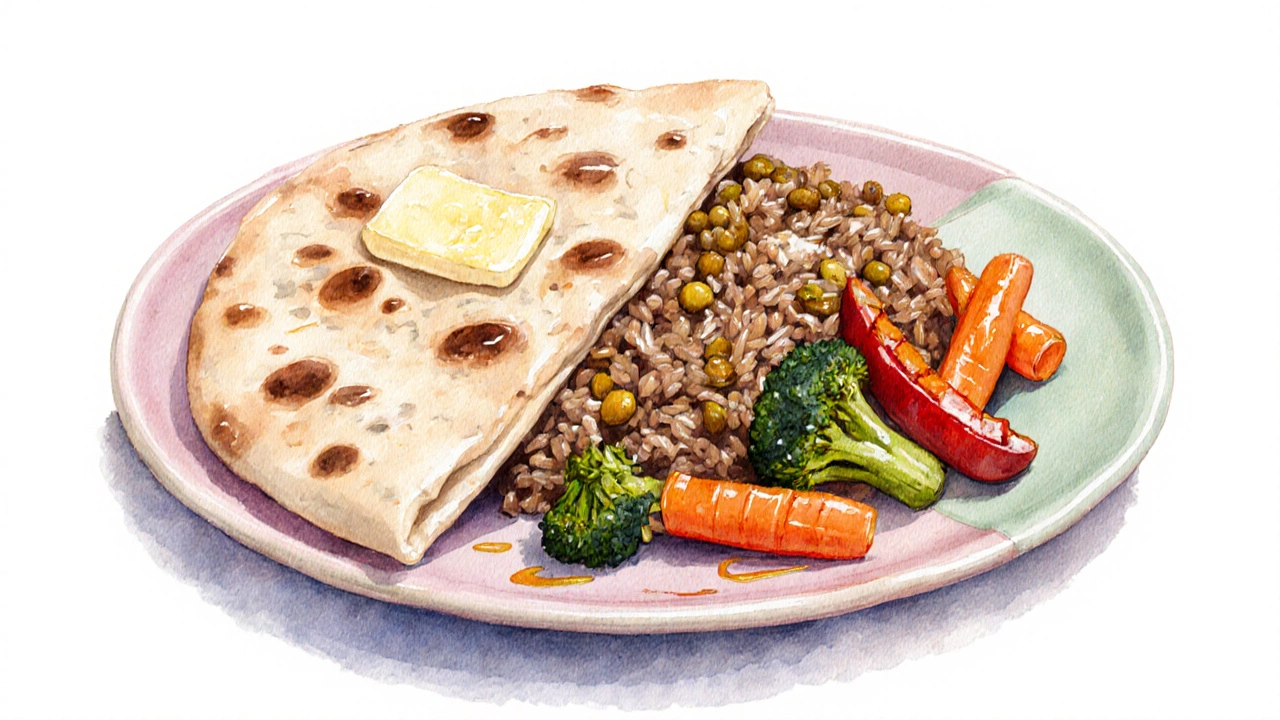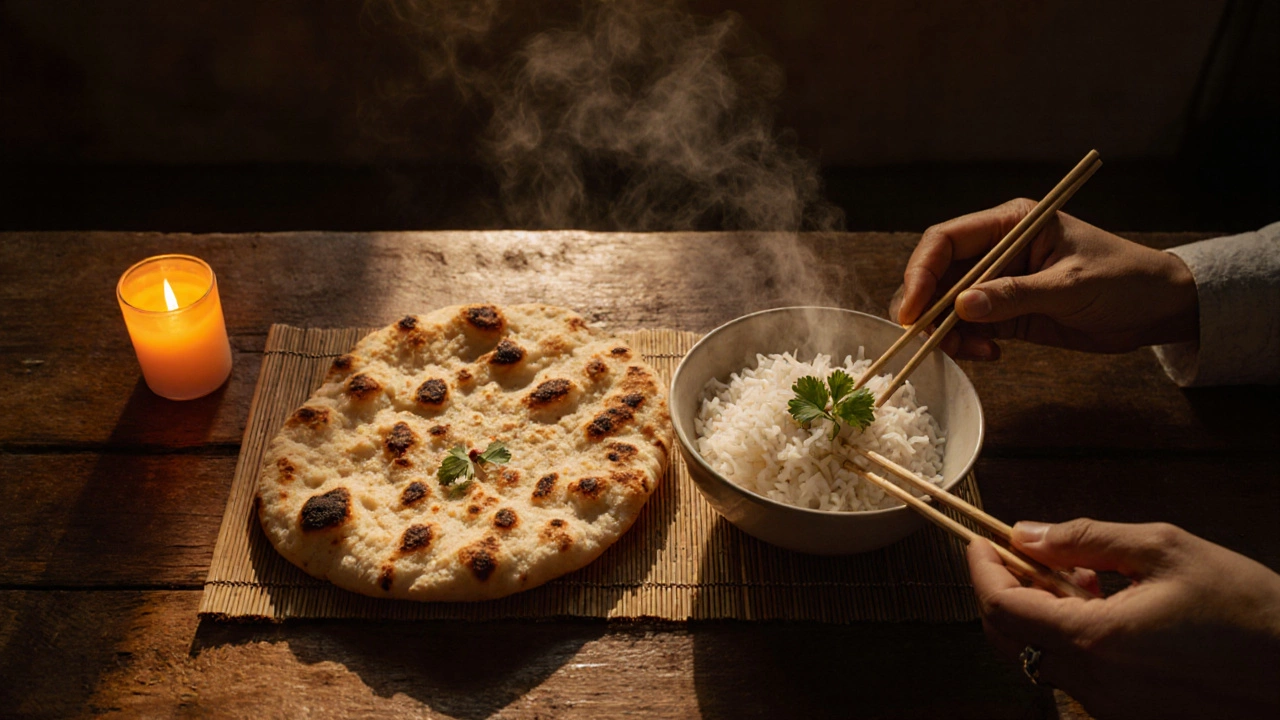Carb & Nutrient Calculator: Naan vs Rice
Your Portion
Nutritional Comparison
Enter your portion sizes to see the comparison
Calories calculated per 100g: Naan (290 kcal), White Rice (130 kcal), Brown Rice (112 kcal)
Quick Takeaways
- Both naan and rice deliver energy, but their calorie density differs - naan packs more calories per bite.
- White rice spikes blood sugar faster than naan, while brown rice sits somewhere in the middle.
- If you need extra protein and a softer texture, naan is the better pick; for a low‑fat, high‑fiber option, brown rice wins.
- Gluten‑sensitive eaters should skip naan; the rest of the world can enjoy it without worry.
- Portion control matters - a typical serving of naan (≈100g) equals about two slices of whole‑grain bread.
When you sit down to an Indian meal, the choice between soft naan vs rice feels like a tiny decision, but it can shape how you feel hours later. Is the fluffy flatbread a smarter fuel source than a steaming bowl of grains? Let’s break down the facts, chew over the numbers, and see which side wins for different goals - weight management, blood‑sugar control, and everyday satiety.
What Is Naan?
Naan is a leavened flatbread traditionally baked in a tandoor, made from wheat flour, water, yeast, and a touch of yogurt or milk. Its dough is stretched thin, slapped onto the hot oven walls, and cooked at temperatures above 480°F. The result is a slightly charred, pillowy slice that soaks up sauces like a champ. Typical recipes add a bit of ghee or butter, which adds flavor and a modest amount of fat.
What Is Rice?
Rice is a cereal grain harvested from the Oryza sativa plant, available in many varieties such as white, brown, basmati, and jasmine. After harvesting, the grain can be milled to remove the husk (brown rice) and further polished to strip the bran and germ (white rice). The cooking method - boiling, steaming, or pressure cooking - determines texture, but the base nutrition stays largely the same across varieties, with subtle differences in fiber and micronutrients.

Nutritional Profile Comparison
| Nutrient | Naan | White Rice | Brown Rice |
|---|---|---|---|
| Calories | 290kcal | 130kcal | 112kcal |
| Carbohydrates | 50g | 28g | 23g |
| Protein | 9g | 2.7g | 2.6g |
| Dietary Fiber | 2g | 0.4g | 1.8g |
| Fat | 6g | 0.2g | 0.9g |
The table shows that naan carries almost double the calories of white rice and a quarter more than brown rice. Its higher protein content (9g) can help muscle repair, especially for vegetarians who rely on wheat‑based proteins. However, the extra fat - often from added ghee - adds to the calorie load.
Glycemic Impact and Blood Sugar
Glycemic Index is a scale that ranks carbohydrate‑containing foods by how quickly they raise blood glucose levels after eating. White rice typically scores 70-80, putting it in the high‑GI category. Brown rice drops to about 50, while naan lands around 55-60 thanks to the wheat’s gluten matrix and the modest fat from butter or oil.
Why does a modest difference matter? For people with type2 diabetes or anyone watching blood‑sugar spikes, high‑GI foods can cause a rapid rise followed by an energy crash. Naan’s slightly lower GI means a gentler ascent, though portion size still dictates the overall glucose load. Swapping a large serving of white rice for a moderate slice of naan can shave off 15-20g of quickly absorbable carbs.
Satiety, Fiber, and Weight Management
Satiety - the feeling of fullness - hinges on three factors: volume, protein, and fiber. Naan brings protein to the table, but its fiber content (2g) lags behind brown rice’s 1.8g and especially whole‑grain breads that can hit 3-4g per slice. Brown rice, with its intact bran layer, often keeps you fuller longer despite lower protein.
Practical tip: Pair naan with a high‑fiber dal or roasted veggies, and you’ll boost the overall fiber score of the meal. Pair white rice with a lean protein like grilled paneer and a generous serving of salad, and you’ll mitigate the rapid glucose rise while still feeling satisfied.

Gluten, Allergies, and Dietary Restrictions
If gluten is a no‑go for you, naan is off the menu unless you find a gluten‑free recipe that swaps wheat flour for millet or chickpea flour. Rice, being naturally gluten‑free, remains safe for celiac disease and gluten intolerance.
On the other hand, low‑carb eaters might shy away from both options, but naan can be tweaked. Replace part of the wheat flour with almond flour, cut the carbs by up to 30%, and still retain that comforting chew.
Practical Tips: Choosing the Right Carbohydrate for Your Meal
- Goal: Blood‑Sugar Control - Opt for brown rice or a smaller piece of naan with added fat (ghee) to slow absorption.
- Goal: Protein Boost - Naan gives you nearly three times the protein of white rice; choose it when you’re vegetarian and need extra muscle‑building blocks.
- Goal: Low‑Fat Diet - White rice wins, but watch portion sizes. Add a splash of lemon juice or herbs to keep flavor without extra calories.
- Goal: Gluten‑Free - Stick with any rice variety. If you crave bread‑like texture, try cauliflower “naan” made from riced cauliflower, egg, and cheese.
- Goal: Satiety - Combine brown rice with legumes; the duo offers a balanced amino‑acid profile and keeps hunger at bay.
Remember, the “best” choice isn’t universal; it depends on what you’re trying to achieve and how the rest of your plate looks. A balanced Indian meal often mixes carbs, protein, and vegetables, so think of naan and rice as interchangeable pieces in a larger puzzle.
Bottom Line
If you’re after more calories, protein, and a soft bite, naan earns the nod. If you need fewer calories, gluten‑free safety, and higher fiber, brown rice takes the lead. White rice sits in the middle - convenient, low‑fat, but with a high glycemic impact. Tailor your portion, pair wisely, and you’ll get the nutrition you want without sacrificing flavor.
Frequently Asked Questions
Is naan healthier than rice?
Healthier depends on your goal. Naan supplies more protein and calories, which can benefit active people or vegetarians. Rice, especially brown rice, offers fewer calories and more fiber, making it a better fit for weight‑loss or low‑fat plans.
Which has more calories per serving?
A typical 100g serving of naan contains about 290kcal, while the same weight of white rice has roughly 130kcal and brown rice about 112kcal.
Can I eat naan on a low‑carb diet?
Traditional naan is high in carbs, but you can make a low‑carb version using almond or coconut flour, reducing the carb count by 30‑40% while keeping a similar texture.
Is brown rice better for blood sugar than naan?
Brown rice has a lower glycemic index (≈50) than naan (≈55‑60), so it causes a slower rise in blood glucose. For tight glucose control, brown rice is the safer pick.
What should I pair with naan to maximize nutrition?
Combine naan with protein‑rich dishes like chana masala, paneer tikka, or lentil dal, and add a side of roasted vegetables. The protein balances the carbs, and the veg adds fiber and micronutrients.
